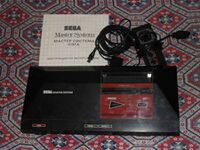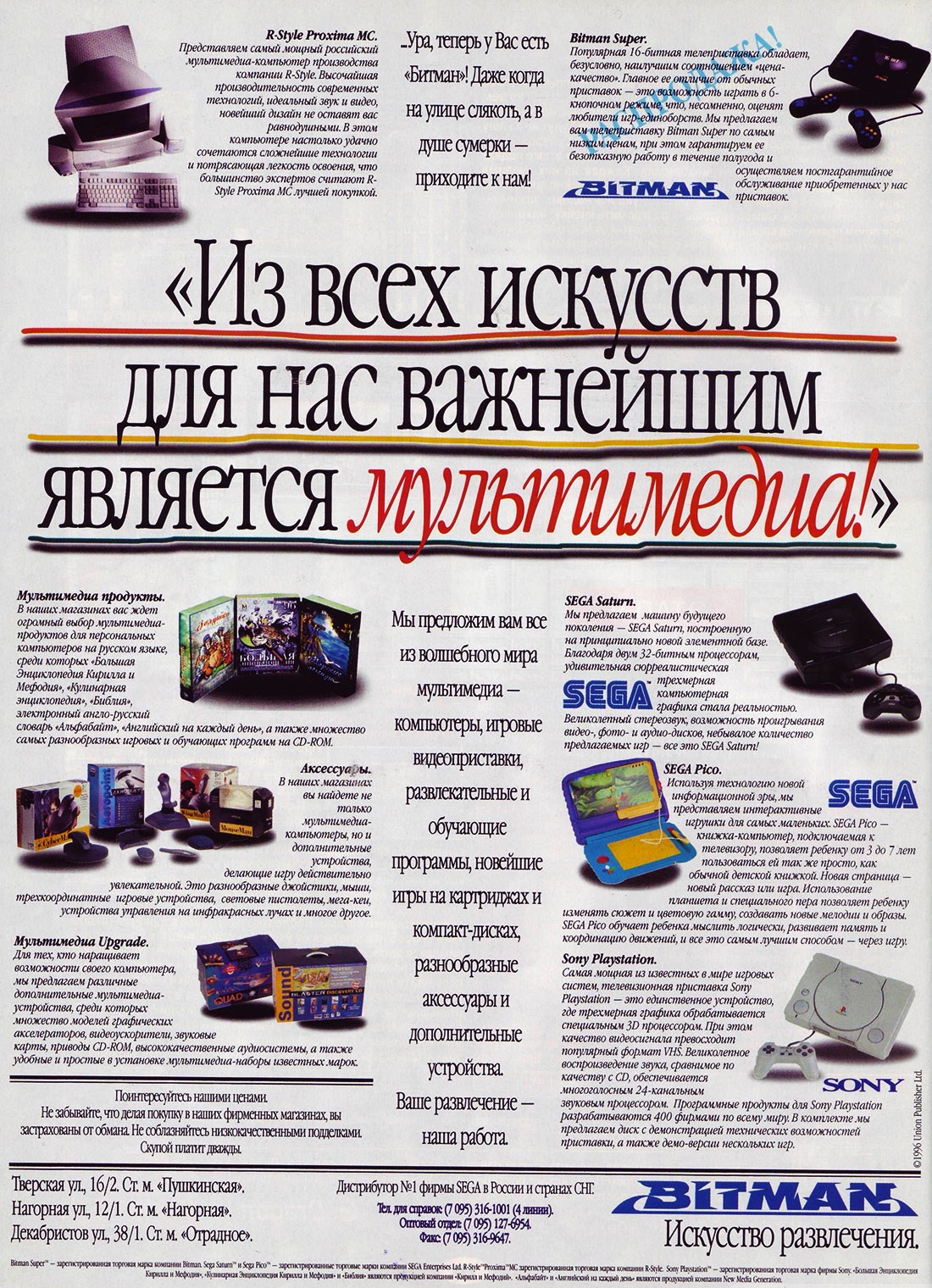History of Sega in Russia
From Sega Retro

|
| History of Sega in Russia |
|---|
| Official Sega distributor(s): Forrus (1994-1996), Bitman (1996-1997), R-Style (1997-1999), Buka (1996-1999), NVT (2000-2002) , 1C-SoftClub (2004-present) |
The modern state of Russia (known officially as the Russian Federation), emerged as an independent state in December 1991, following the demise of the Soviet Union (USSR). The move from a one-party communist state to a more Western-style capitalist society, meant that luxary items such as video games were able to become more widespread. Sega has been involved in the region in various guises since at least 1990.
Contents
Sega Master System
While video games had existed in Russia during the days of the Soviet Union (Tetris being the most well-known example of a Russian video game export), virtually no Western video game companies chose to sell their products inside the bloc.
Curiously Sega had a go at selling the Sega Master System (model no. MK-3096-19) inside the Russian SFSR in 1990. The elusive Russian Master System outputs a SECAM signal (for compatiblity with the Soviet TV standard) and lacks both a card slot and reset button, much like redesigned Master System II console seen elsewhere. Little is known about the console's fortunes, though given its rarity, it is unlikely to have been a success.
It is possible that the state-run retail stores Beryozka that imported products from abroad could sign a contract with Sega for the sale of the console. All contracts were canceled after the collapse of the USSR in 1991.
Dendy
Russia's video game market is widely considered to have been created when Russian importing company, Steepler, created the "Dendy", an own-branded Nintendo Famicom sourced from Taiwanese manufacturers. At the time, no legislation existed in Russia to protect video game copyrights - while cloning games and hardware was both illegal in much of the world, the Dendy and its derivatives were perfectly legal in Russia - Nintendo could not stop the console's distribution, and didn't.
With a fully fledged marketing campaign, Steepler was able to dominate its home market, but the economical situation in Russia meant that Dendy was out of reach of most consumers, costing several months' worth of the average worker's salary (and indeed in 1993 it was estimated that 39-49% of the population was classed as being in poverty). Steepler were able to bring the costs down as the years went on however, bringing the console into a more affordable price range around 1994.[1]
Forrus
In 1993 Nissho Iwai (a Japanese firm which had operated in Russia for decades) got the rights to sell Sega consoles in Russia. The company decided to look for a distributor who wabt to sell consoles in the country. Negotiations have started with Steepler who, seeing the success of Sega Mega Drive in Europe, also wanted to repeat it in Russia. Nissho Iwai was ready to start cooperation but the company wanted from Steepler to break all contracts with Taiwanese companies that produced Dendy. Steepler did not want to do this and in 1994 the negotiations ended.
Seeing the success of the Dendy, other distributors tried to get into the act, and through Nissho Iwai and its chosen distributor, Forrus, Sega re-entered the Russian market around August 1994. Sega would sell stock to Nissho Iwai, who would sell it to Forrus, who would distribute to retailers across the country.[2]
Under this arrangement, the Sega Mega Drive (model 2), Sega Master System (model 2), Sega Mega-CD (model 2), Sega Game Gear and Sega Multi Mega were officially sold in Russia, with the same selection of PAL games seen in Europe (at least, in regards to first-party releases). However despite widespread publicity and even the commissioning of a weekly television show promoting Sega products, the endeavour appears not to have been a particular success, with the distribution rights getting given to a new company within two years.
Competition
While Sega had an official distributor in Russia, the laws governing copyright had yet to change, meaning Forrus was forced to fight against other distributors armed with clone Sega hardware.
Not content with just marketing Dendy consoles, Steepler used its position of market leader to market its Mega Drive clone, the Pro 16 Bit. Its distribution channels and associated Dendy brand helped drive sales across the nation - at this point the Dendy was synonymous with video games in general, leading to curious situations were consoles would be referred to as "Nintendo Dendys" or "Sega Dendys". Steepler also distributed its products around the wider CIS region (formed by former republics of the USSR) and Baltic States , giving it a territorial advantage over Forrus.
Steepler sold games and consoles from USA, Asia and pirate versions. Special games were bought from stores operating in the US, Japan and Thailand and imported to Russia. Steepler and Dendy sold Sega Mega Drive produced in Taiwan which looked almost the same as the original consoles , Japanese version of Mega Drive, European versions of Mega Drive (very rare), Sega Game Gear in Asian version and Sega Genesis CDX.
Its Sega operations were cut short in 1994, however, when the company was chosen by Nintendo as the official distributor of the Super NES in former USSR countries. While the agreement permitted the unlicensed Dendy consoles to be sold, sales of rival products (such as Sega) was restricted.[3] The high costs of importing genuine SNES consoles and cartridges from Germany took its toll on Steepler, which folded in 1996.Sega products were also sold by Dendy, a chain of stores created by Steepler, but they also saw limitations from Nintendo. After the collapse of Steepler in 1996, the company continued to sell Sega consoles until 1998.
Other competitors included Kenga and its Mega-Ken Mega Drive clone, and Subor with the SB-16C. The true number of smaller organisations selling imported software or accessories is not known.
Bitman,R-Style and Buka
Another major competitor to Forrus was Bitman, established in November 1994. In addition to marketing NES clones, the company launched its own Mega Drive, the Super Bitman, based on the infamous KW-501 clone console.
Presumably displeased with Forrus' efforts, Bitman was chosen as an official Sega distributor for Russia. At a joint press conference on June 6th, 1996 Sega Europe and Bitman announced that the latter was to become the new distributor for both Russia and the CIS countries. With its own chain of stores, Bitman was able to distribute the Mega Drive 2, Sega Saturn , Sega Mega-CD model 2 , Sega Game Gear, Sega 32X and Sega Pico in addition to the Super Bitman.[4]
In 1997, Bitman was acquired by R-Style, who inherited Sega's distribution agreement. R-Style continued selling the Saturn and Mega Drive II in the region until the end of the 1990s.
Representative in 1996 was the company Buka (Бука) who at the same time became a representative of Nintendo and Sony in Russia and CIS.
In the mid-90 in Russia appeared more Mega Drive clones.The most popular of these were produced by Simba's Video Games.Most of them looked like Playstation.The company also produced accessories for console such as a code writer.Antoher problem for official distributors was the importers who imported consoles and games to Russia mainly from the USA.They released Sega Nomad in Russia in 1997.Because the console couldn't work with PAL cartidges , local distibutors decided to promote Mega Key to pass regional blockade. Accessories for Mega Drive were also imported such as controllers and even XB∀ND.
Despite the collapse of Steepler, there was still Dendy, which continued selling Sega Mega Drive without a license, and Sega Saturn in the US version until 1998 when the company collapsed.
Game crisis in Russia
In 1998, an economic crisis occurred in Russia. The original games started to cost huge amounts of money. Looking at the market, there is huge piracy and cheap imports, many have realized that the official distribution has no future in Russia. Buka took a dramatic step and decided to start selling games in an economical way, that is, by using less expensive materials to create, for example, packaging. At first glance, the games looked like pirate ones.The company also agreed with game producers to lower the prices of their games in Russia. These actions proved to be effective and other companies started using this method. Buka decided in 1999 to stop selling Sega consoles and focus on the sale of computer games and games created by himself. R-Style decided in the same year began selling everything related to computers. Although piracy did still exists, government and other companies tried to fight with that, but many times this did not take effect.
Sega Dreamcast
The Sega Dreamcast also made it to the country.In 2000 NVT was appointed a distributor and started selling consoles.[5] There was also a manual in Russian and it was usually added to European models that came from Big Ben Interactive which from 2001 was a distributor in Western Europe.Occasionally, importers of consoles from Japan could be found.The console has gained some popularity.The original games were rare and pirate games were popular, which were translated into Russian. This games were distributed with custom-made packaging . There were a few companies that translated and sold pirate games:
- Vector (Вектор)
- Kudos
- RGR Studio
- Paradox (Do not be confused with another company that produce games)
- Playzero
- Pinachet Game
1C-SoftClub
In 2004 SoftClub became a distributor of Sega in Russia and CIS, which became a part of the company 1C.More modern games for the PlayStation 2 and beyond seem to be distributed in Russia legally without much concern. The country seems to have adopted the PEGI rating system and games are translated into Russian in a similar manner to other European regions.
Mega Drive Portable
During the mid-2000s when the technology became inexpensive, a new Mega Drive "standard" was adopted by a set of unknown Russian companies under the banner of Mega Drive Portable. Games were placed in custom-made Game Boy Advance-style cartridges and are compatible in a number of different devices, most of whom steal design tips from Nintendo consoles. Once again the legality is questioned.
New Game Consoles
At the beginning of the 21st century, besides Simba's , clones were also sold by New Game. The company translate Mega Drive games into Russian and produce their own set of consoles - the Magistr Drive.
- Magistr Drive Russia.jpg
Advertisement about Magistr Drive in 2000
- New Game Russia 2.jpg
- New Game Russia 3.jpg
- New Game Russia 1.jpg
Homebrew Games
There appears to be a strong homebrew Mega Drive community in Russia, with many of their creations leaking into the commercial market by dodgy eBay sellers.
AtGames Presence
AtGames products are present in this region and are distributed by Cyber Toy. A good chunk of their consoles have been released in the region, including the Arcade Classic and the Arcade Ultimate. Blue and green versions of the Arcade Ultimate appeared in Russia before other regions of the world (namely the UK, in which Blaze Europe introduced the blue variant in 2011), suggesting strong support from AtGames in that region.
The Micro Drive is currently exclusive to Russia.
KidsPlay
Since 2006, the distribution of arcade machines and equipment for children produce by Sega is being carried out by KidsPlay.[6]
References
- ↑ http://tv-games.ru/wiki/Companies/Steepler.html
- ↑ https://www.kommersant.ru/doc/10153
- ↑ https://www.kommersant.ru/doc/94004?query=steepler
- ↑ https://www.kommersant.ru/doc/233963?query=bitman
- ↑ https://web.archive.org/web/20010409225930/http://sega.ru:80/news.phtml
- ↑ http://brunswickbowling.kz/about/sng.php





